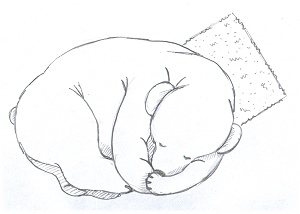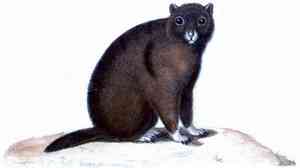In October, the marmot enters a period of hibernation, which lasts about six months. Here, the need for sleep is more important than in average sleepers (more than 10 hours).
No matter how intense his/her « stress level » can be, that subject will never know the dread of insomnia.
He/she is under a constant excessive sleep pressure and takes advantage of every opportunity to « doze off a little ». (And is teased by friends how consider him/her like a « marmot »).
If possible, the person will adopt fitted out work schedules which leave opportunities to satisfy his/her need for sleep.
The diagnosis requires that pseudo-hypersomnias and secondary hypersomnias are taken into account.
Sleep insufficiency because of an excessive need ...He/she is under a constant excessive sleep pressure and takes advantage of every opportunity to « doze off a little ». (And is teased by friends how consider him/her like a « marmot »).
If possible, the person will adopt fitted out work schedules which leave opportunities to satisfy his/her need for sleep.
The diagnosis requires that pseudo-hypersomnias and secondary hypersomnias are taken into account.
Is the subject a "big sleeper"?
Normal sleep duration varies a lot : statistics show that 35% of the population sleeps less than 5 hours or more than 9 hours. The notion of «big sleeper » must imperatively lead to sleep explorations in order to confirm the diagnosis and to exclude the possibility of an underlying illness :
The notion of «big sleeper » must imperatively lead to sleep explorations in order to confirm the diagnosis and to exclude the possibility of an underlying illness :- narcolepsy without cataplexy;
- respiratory sleep disorders (SAS, UARS);
- or other... (epilepsy, restless legs, nocturnal sleep deprivation, jetlag ...)
Idiopathic hypersomnia
When the excessive need for sleep has no detectable cause and implies a true handicap, idiopathic hypersomnia is mentioned.That type of "extreme big sleeper" presents an excellent sleep quality when recorded, which only remarkable features are its duration and depth (rich in slow wave activity).
Even if the subject has slept well the night before recording (so that a sleep debt can be excluded), he/she falls asleep during more than one of the 5 naps which make the test which measures sleepiness objectively.
- The marmot hibernates during six months
In the typical forms, starting off in the morning is very difficult.
In modern life conditions, the subject has to compensate a chronic failure in order not to suffer from sleep insufficiency and excessive daytime sleepiness. Yet, the subject often prefers to avoid the naps because waking up is particularly difficult here, with sensations of sleep drunkenness and confusion which sometimes last a long time. The excessive sleepiness mostly appears in going to sleep early and getting up late.
If the handicap justifies it (the subject has the feeling of being « stoned » all the time), arousing molecules like cafeine, amphetamine or amphetamine-related (modafinil) can sometimes be resorted to in order to help the subject to live more normally (but troubles with waking up remain).
Differential diagnosis : « pseudo-hypersomnias »
- Hypersomnia induced by medication
: apart from sedatives (which intake explains sleepiness), many
medications interfere with sleep. The habit of taking a medication in
the evening, because of the risk of a sedative effect, is no longer
valid by the light of current sleep knowledge.
(Recent notions of chronobiology confirm that the elimination speed of medications varies a lot according to the nycthemeron).
It foresaw one colour meaning that driving is forbidden, one colour which meant that a medical opinion was necessary and one colour to draw the attention on a potential risk.
There are few medications for which it is possible to exclude any risk for sleep.
Beta-blockers (used in hypertension, sometimes because of their anti-stress effect) must be particularly avoided in the evening because they inhibit the synthesis of melatonin, which gives the signal « night » to the organism.
- Hypersomnia and addictive behaviours.
Alcohol and opiates (codein, morphine, heroin) induce a very bad sleep quality. The diurnal compensatory sedation which results from it can appear like an hypersomnia. Despite its very ancient traditional use (the sect of the « Hashishin » which drugged its members to give them a foretaste of paradise), the effect of cannabinoids on sleep has not been studied very much.
Yet, some recent publications show properties which could reveal interesting. They seem to increase slow and REM sleep and might present numerous applications in food balance, pain mechanisms and the immune system.
- Some mood disorders like depression sometimes
take the shape of an apparent hypersomnia, but the sleep record shows,
here, a degradation of the night sleep architecture (fragmentation,
shortening of REM latency, delayed slow wave sleep in the end of the
night).
Diurnal sleep is so light that the term of « clinophilia » is used, which means «wish to lie down ». That type of disturbance responds favourably to a well-conduced anti-depressant treatment and, in that case, the normalisation of the hypnogram precedes that of the mood.
It is thus possible to consider the EEG diagram like a predictive marker of the efficiency of the medication.
A promising path for the future of somnology...
Some psychiatry units proceed to (under control) sleep deprivations (combined with an antidepressant) in subjects who suffer from severe depression and meet a lot of success doing so.
- Kleine-Levin syndrome
It is a quite strange form of hypersomnia which occurs in recurrent attacks, sometimes coupled with sexual or food-related behaviour disorders.
These attacks, which last a couple of days with a variable period and mostly affects boys, were often noticed during military duty.
Sometimes mentioned in specialized litterature, that chart had become so rare (with the disappearance of military duty?), that some doubted its reality, but the CHU of Montpellier regularly checks in new cases of the disorder.
Progress with human genome allow to assert the genetic origin of the illness, which matches a small chromosomic anomaly.
Like in sleepwalking or bedwetting, the appearance of the illness matches the circumstanciated expression of a preexisting ground.
- Teenage is a critical period of sleep maturation.
The teenager put in «constant routine » conditions (in the situation of sleeping as much as possible) shows a need for sleep that is identical to that of the youngest (from 10 to 12 hours), but fun conditions in the evenings, as well as school requirements, do not allow him/her to sleep as much as needed.
The building of a sleep debt follows from that but, at that age, sleep possesses important recovery abilities (during week-ends and holidays) as it can be seen on the sleep diary.
Sometimes, that great plasticity favours a sleep onset insomnia and a phase delay syndrome. - Pregnancy often carries with it a form of physiological hypersomnia.
In our experience, the future mother often notices a sudden excess of sleep from the start of pregnancy.
The influence of the hormonal upsetting which goes with pregnancy is such, that the appearance of sleepiness in that context can be considered like one of its first clinical signs.
Later, the establishing of the little one’s chronobiological rhythms requires a more or less long adaptation period which the mother has to endure, and the well-know post-partum baby blues seems to us to belong to the field of tiredness rather than to that of depression.

